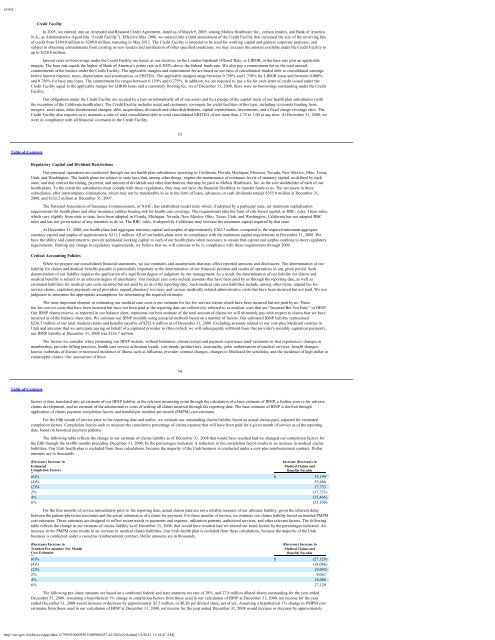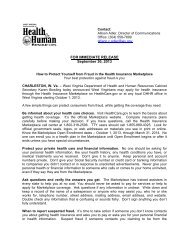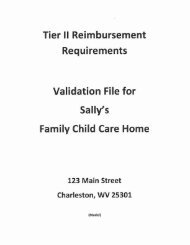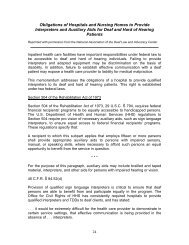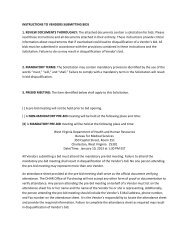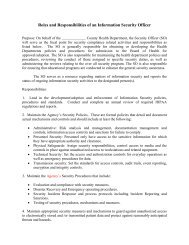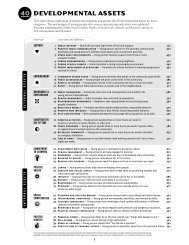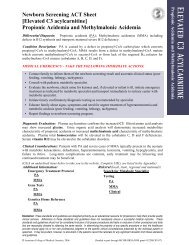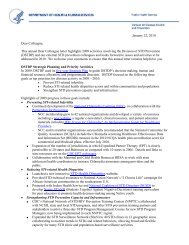Molina Medicaid Solutions - DHHR
Molina Medicaid Solutions - DHHR
Molina Medicaid Solutions - DHHR
Create successful ePaper yourself
Turn your PDF publications into a flip-book with our unique Google optimized e-Paper software.
e10vkCredit FacilityIn 2005, we entered into an Amended and Restated Credit Agreement, dated as of March 9, 2005, among <strong>Molina</strong> Healthcare Inc., certain lenders, and Bank of AmericaN.A., as Administrative Agent (the “Credit Facility”). Effective May 2008, we entered into a third amendment of the Credit Facility that increased the size of the revolving lineof credit from $180.0 million to $200.0 million, maturing in May 2012. The Credit Facility is intended to be used for working capital and general corporate purposes, andsubject to obtaining commitments from existing or new lenders and satisfaction of other specified conditions, we may increase the amount available under the Credit Facility toup to $250.0 million.Interest rates on borrowings under the Credit Facility are based, at our election, on the London Interbank Offered Rate, or LIBOR, or the base rate plus an applicablemargin. The base rate equals the higher of Bank of America’s prime rate or 0.500% above the federal funds rate. We also pay a commitment fee on the total unusedcommitments of the lenders under the Credit Facility. The applicable margins and commitment fee are based on our ratio of consolidated funded debt to consolidated earningsbefore interest expense, taxes, depreciation and amortization, or EBITDA. The applicable margins range between 0.750% and 1.750% for LIBOR loans and between 0.000%and 0.750% for base rate loans. The commitment fee ranges between 0.150% and 0.275%. In addition, we are required to pay a fee for each letter of credit issued under theCredit Facility equal to the applicable margin for LIBOR loans and a customary fronting fee. As of December 31, 2008, there were no borrowings outstanding under the CreditFacility.Our obligations under the Credit Facility are secured by a lien on substantially all of our assets and by a pledge of the capital stock of our health plan subsidiaries (withthe exception of the California health plan). The Credit Facility includes usual and customary covenants for credit facilities of this type, including covenants limiting liens,mergers, asset sales, other fundamental changes, debt, acquisitions, dividends and other distributions, capital expenditures, investments, and a fixed charge coverage ratio. TheCredit Facility also requires us to maintain a ratio of total consolidated debt to total consolidated EBITDA of not more than 2.75 to 1.00 at any time. At December 31, 2008, wewere in compliance with all financial covenants in the Credit Facility.53Table of ContentsRegulatory Capital and Dividend RestrictionsOur principal operations are conducted through our ten health plan subsidiaries operating in California, Florida, Michigan, Missouri, Nevada, New Mexico, Ohio, Texas,Utah, and Washington. The health plans are subject to state laws that, among other things, require the maintenance of minimum levels of statutory capital, as defined by eachstate, and may restrict the timing, payment, and amount of dividends and other distributions that may be paid to <strong>Molina</strong> Healthcare, Inc. as the sole stockholder of each of ourhealth plans. To the extent the subsidiaries must comply with these regulations, they may not have the financial flexibility to transfer funds to us. The net assets in thesesubsidiaries, after intercompany eliminations, which may not be transferable to us in the form of loans, advances, or cash dividends totaled $355.0 million at December 31,2008, and $332.2 million at December 31, 2007.The National Association of Insurance Commissioners, or NAIC, has established model rules which, if adopted by a particular state, set minimum capitalizationrequirements for health plans and other insurance entities bearing risk for health care coverage. The requirements take the form of risk-based capital, or RBC, rules. These rules,which vary slightly from state to state, have been adopted in Florida, Michigan, Nevada, New Mexico, Ohio, Texas, Utah, and Washington. California has not adopted RBCrules and has not given notice of any intention to do so. The RBC rules, if adopted by California, may increase the minimum capital required by that state.At December 31, 2008, our health plans had aggregate statutory capital and surplus of approximately $362.5 million, compared to the required minimum aggregatestatutory capital and surplus of approximately $211.1 million. All of our health plans were in compliance with the minimum capital requirements at December 31, 2008. Wehave the ability and commitment to provide additional working capital to each of our health plans when necessary to ensure that capital and surplus continue to meet regulatoryrequirements. Barring any change in regulatory requirements, we believe that we will continue to be in compliance with these requirements through 2009.Critical Accounting PoliciesWhen we prepare our consolidated financial statements, we use estimates and assumptions that may affect reported amounts and disclosures. The determination of ourliability for claims and medical benefits payable is particularly important to the determination of our financial position and results of operations in any given period. Suchdetermination of our liability requires the application of a significant degree of judgment by our management. As a result, the determination of our liability for claims andmedical benefits is subject to an inherent degree of uncertainty. Our medical care costs include amounts that have been paid by us through the reporting date, as well asestimated liabilities for medical care costs incurred but not paid by us as of the reporting date. Such medical care cost liabilities include, among other items, unpaid fee-forserviceclaims, capitation payments owed providers, unpaid pharmacy invoices, and various medically related administrative costs that have been incurred but not paid. We usejudgment to determine the appropriate assumptions for determining the required estimates.The most important element in estimating our medical care costs is our estimate for fee-for-service claims which have been incurred but not paid by us. Thesefee-for-service costs that have been incurred but have not been paid at the reporting date are collectively referred to as medical costs that are “Incurred But Not Paid,” or IBNP.Our IBNP claims reserve, as reported in our balance sheet, represents our best estimate of the total amount of claims we will ultimately pay with respect to claims that we haveincurred as of the balance sheet date. We estimate our IBNP monthly using actuarial methods based on a number of factors. Our estimated IBNP liability represented$236.5 million of our total medical claims and benefits payable of $292.4 million as of December 31, 2008. Excluding amounts related to our cost-plus <strong>Medicaid</strong> contract inUtah and amounts that we anticipate paying on behalf of a capitated provider in Ohio (which we will subsequently withhold from that provider’s monthly capitation payment),our IBNP liability at December 31, 2008 was $216.7 million.The factors we consider when estimating our IBNP include, without limitation, claims receipt and payment experience (and variations in that experience), changes inmembership, provider billing practices, health care service utilization trends, cost trends, product mix, seasonality, prior authorization of medical services, benefit changes,known outbreaks of disease or increased incidence of illness such as influenza, provider contract changes, changes to <strong>Medicaid</strong> fee schedules, and the incidence of high dollar orcatastrophic claims. Our assessment of these54Table of Contentsfactors is then translated into an estimate of our IBNP liability at the relevant measuring point through the calculation of a base estimate of IBNP, a further reserve for adverseclaims development, and an estimate of the administrative costs of settling all claims incurred through the reporting date. The base estimate of IBNP is derived throughapplication of claims payment completion factors and trended per member per month (PMPM) cost estimates.For the fifth month of service prior to the reporting date and earlier, we estimate our outstanding claims liability based on actual claims paid, adjusted for estimatedcompletion factors. Completion factors seek to measure the cumulative percentage of claims expense that will have been paid for a given month of service as of the reportingdate, based on historical payment patterns.The following table reflects the change in our estimate of claims liability as of December 31, 2008 that would have resulted had we changed our completion factors forthe fifth through the twelfth months preceding December 31, 2008, by the percentages indicated. A reduction in the completion factor results in an increase in medical claimsliabilities. Our Utah health plan is excluded from these calculations, because the majority of the Utah business is conducted under a cost-plus reimbursement contract. Dollaramounts are in thousands.(Decrease) Increase in Increase (Decrease) inEstimated Medical Claims andCompletion Factors Benefits Payable(6)% $ 53,199(4)% 35,466(2)% 17,7332% (17,733)4% (35,466)6% (53,199)For the four months of service immediately prior to the reporting date, actual claims paid are not a reliable measure of our ultimate liability, given the inherent delaybetween the patient/physician encounter and the actual submission of a claim for payment. For these months of service, we estimate our claims liability based on trended PMPMcost estimates. These estimates are designed to reflect recent trends in payments and expense, utilization patterns, authorized services, and other relevant factors. The followingtable reflects the change in our estimate of claims liability as of December 31, 2008, that would have resulted had we altered our trend factors by the percentages indicated. Anincrease in the PMPM costs results in an increase in medical claims liabilities. Our Utah health plan is excluded from these calculations, because the majority of the Utahbusiness is conducted under a cost-plus reimbursement contract. Dollar amounts are in thousands.(Decrease) Increase in (Decrease) Increase inTrended Per member Per Month Medical Claims andCost Estimates Benefits Payable(6)% $ (27,129)(4)% (18,086)(2)% (9,043)2% 9,0434% 18,0866% 27,129The following per-share amounts are based on a combined federal and state statutory tax rate of 38%, and 27.8 million diluted shares outstanding for the year endedDecember 31, 2008. Assuming a hypothetical 1% change in completion factors from those used in our calculation of IBNP at December 31, 2008, net income for the yearended December 31, 2008 would increase or decrease by approximately $5.5 million, or $0.20 per diluted share, net of tax. Assuming a hypothetical 1% change in PMPM costestimates from those used in our calculation of IBNP at December 31, 2008, net income for the year ended December 31, 2008 would increase or decrease by approximatelyhttp://sec.gov/Archives/edgar/data/1179929/000095013409005437/a51362e10vk.htm[1/6/2012 11:14:47 AM]


